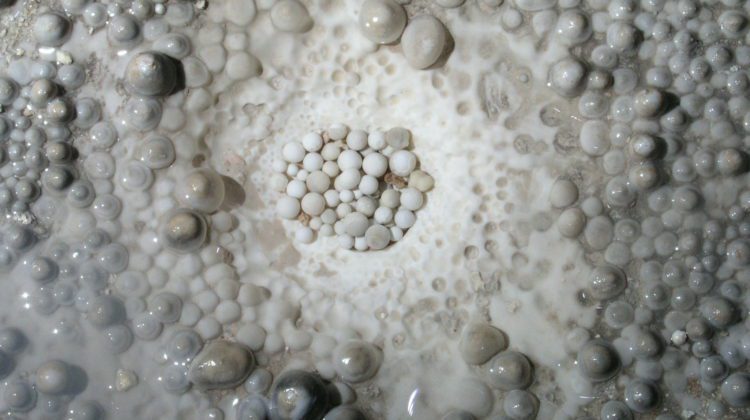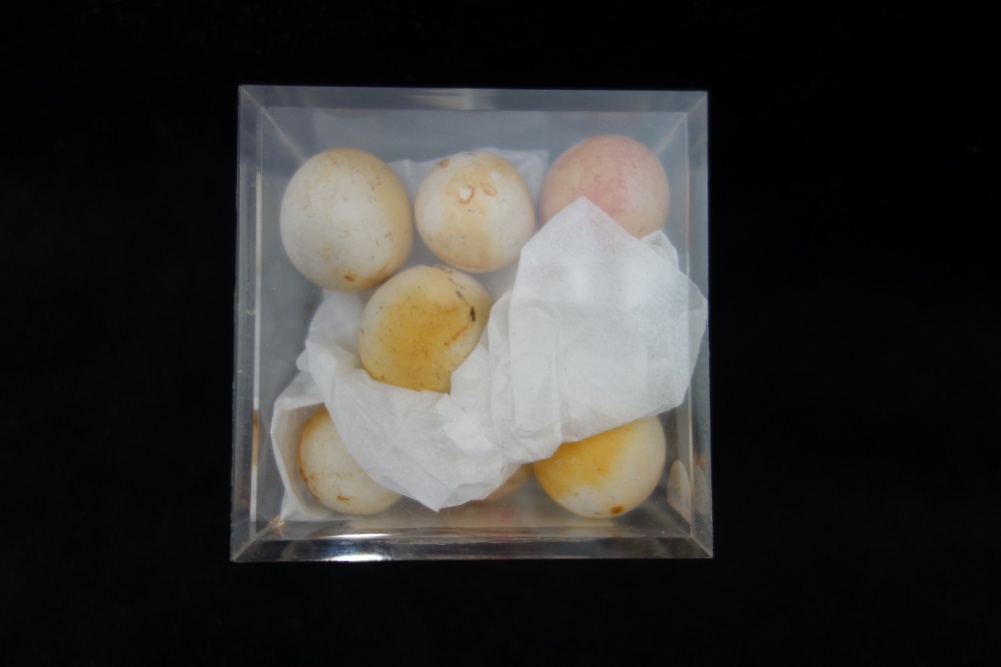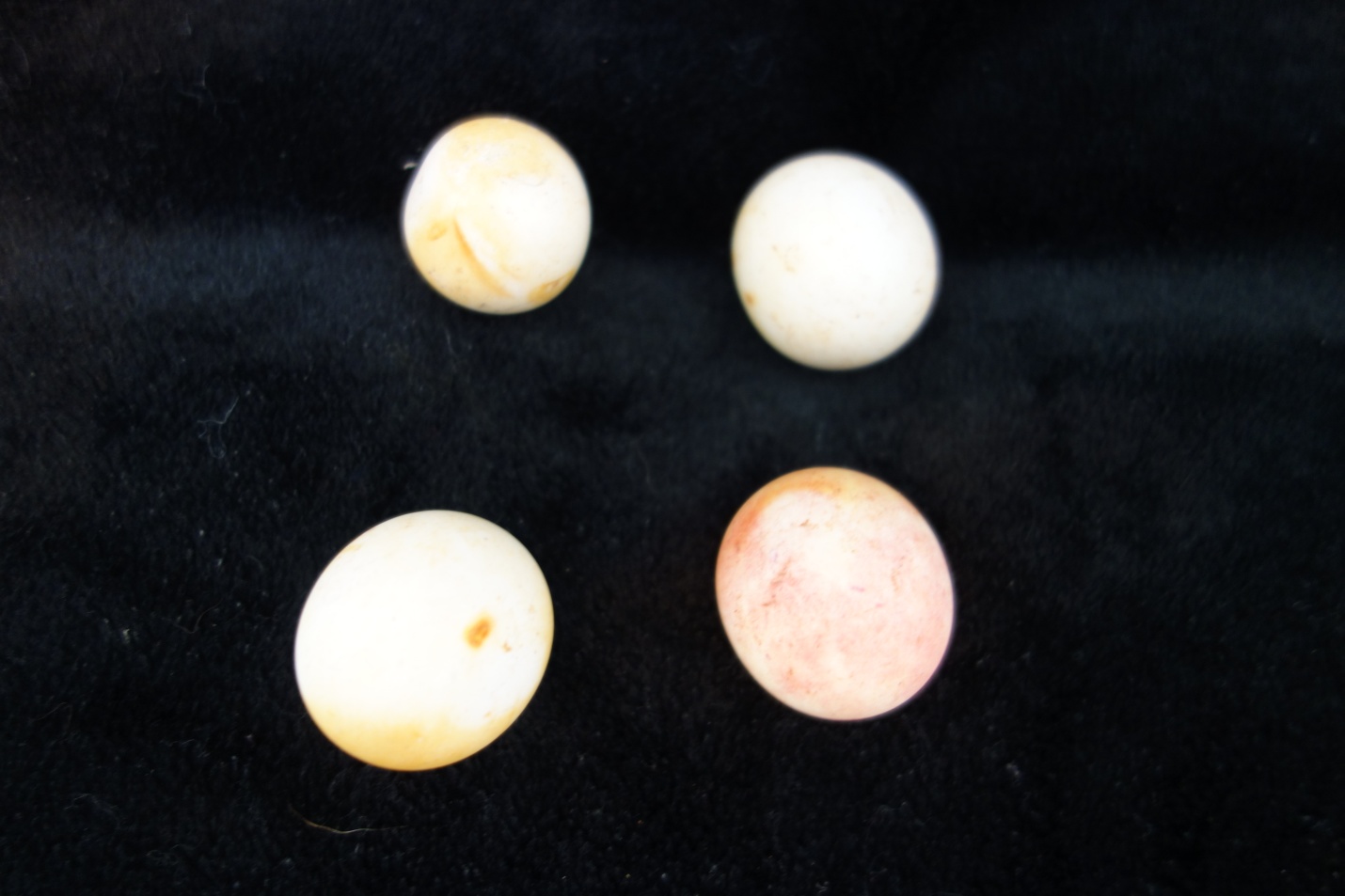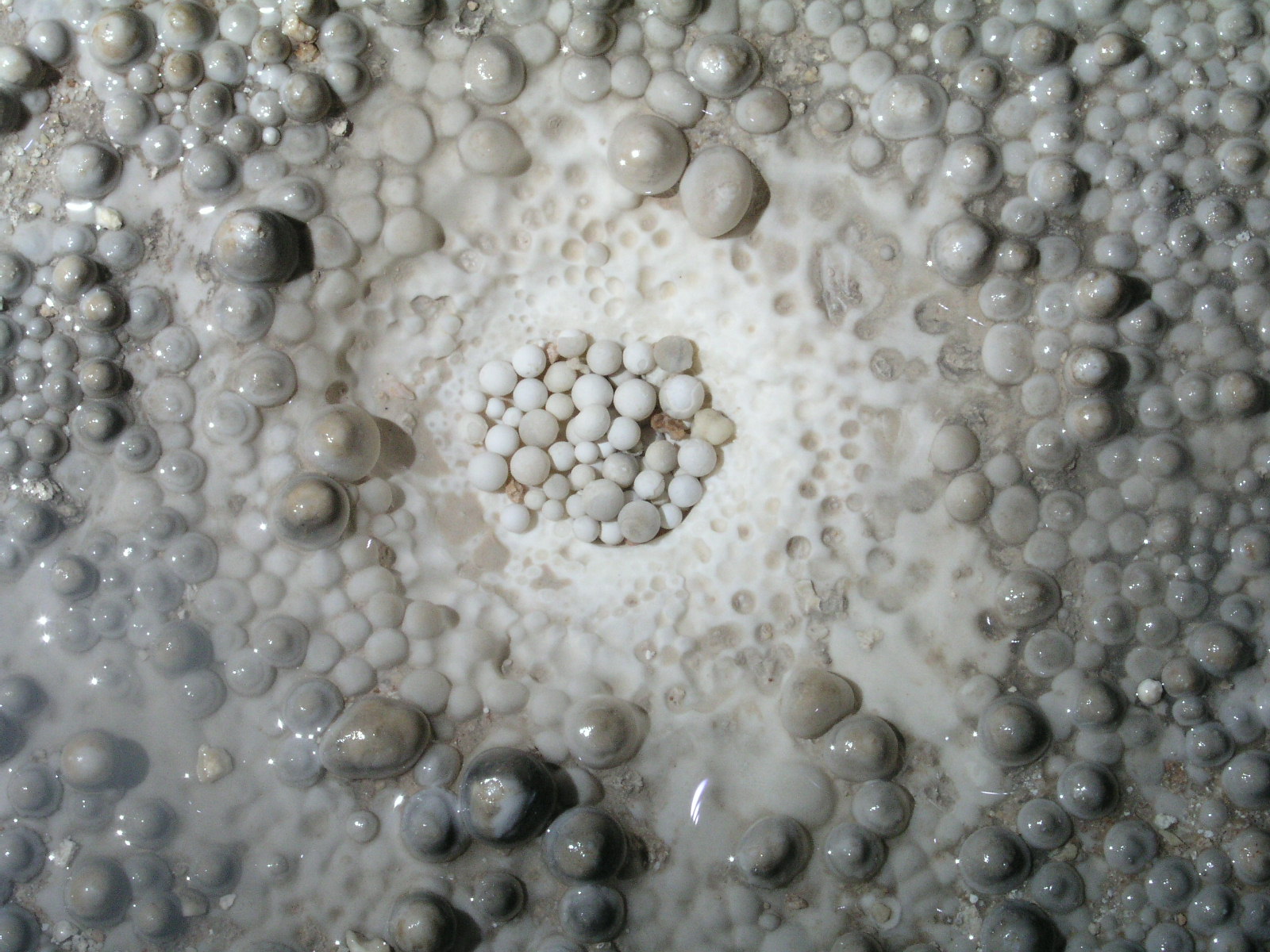
File: Cave Pearls—Rookery, Lower Cave, Carlsbad Cavern (51202462532).jpg[1]
“There are more things in Heaven and Earth, Horatio, than are dreamt of in your philosophy.” Hamlet, I.5
Cave What?
We wrote about natural marbles in one of our earliest posts Marbles from Mother Nature. One type, Cave Pearls, is an international phenomenon and may have been used by indigenous peoples around the world.
Have you ever heard of them? Ever found them in a cavern? Look at the lead photograph again. These “pearls” are in a natural “nest” and they are different sizes and colors. The nest appears to be dry but it may be under an inch or so of water. Have you ever seen anything other than these “pearls” which occur in nature that look so perfectly like a toy marble? Why aren’t they called cave marbles rather than pearls? Obviously, there are small cave pearls, but most are player marble size, about ⅝”, or shooters at ¾” to 1”.
Flashback: Ooliths or Fish Eggs?

We first researched cave pearls, which are also called ooliths[2]; from the Greek for “fish egg”, in 2010 when Larry’s sister gave us some from a lot she bought in Kennesaw, Georgia. While shopping at an antiques store she found a dusty old jar with a lightning closure high on a shelf. Labeled simply “marbles”, it contained twenty ooliths or small spherules. Lynn gifted us with eight of the “marbles” from the old jar.
We had no idea what they were. Sold as marbles, and sometimes even called “Indian marbles”, we quickly realized that they are not glass, stone, nor clay. As a general rule the orbs are perfectly smooth, the outside is naturally polished of varying sizes, and some have flat or planar surfaces. The pearls with some flat planes are called subspherical. Ours range in size from about 15/16” to 1⅛”. One is colored a pink/red, and all of them have what appears to be ferris oxide stains. The dyed one has stains under the dye. The pink one is top row far right in the plastic container.
What We Learned
We learned fairly quickly that they are speleothem and, more specifically, cave pearls. Here is a definition of cave pearls: “Pearls are a concentric concretion found in shallow cave pools. They can be spherical … or cylindrical, elliptical, and even cubical. They range in size from barely larger than a grain of sand up to golf-ball sized.”[3]
The phrase “concentric concretion” points to why they are called pearls, or even “fish eggs,” rather than marbles. Fadi H. Nader reported on his petrographic and geochemical study of pearls from Kanaan Cave in Lebanon.
While most pearls do have a polished surface, as you can see in the photograph of some of our ooliths, each and every one is built up of “cortical laminae”: layers and layers built up, mostly, of calcite, over the years. Each oolith has a nucleus: some type impurity around which the layers are built up.
I’ve Got You Under My Skin…
Like sea pearls, the nucleus is some type “irritant”. Often it is a tiny fragment of limestone called terra rossa; it could also be a grain of clay; or, less frequently, something organic like a bone chip. Layers build up over time in a pool of moving water inside a cavern. This movement may be slight and caused by a drip. Nader offers a photograph of the cross-section of nine pearls (page 44) as well as a schematic of the layers of a pearl (page 48).[4] These crosscuts are really neat!
Ooliths, Moonmilk, & Helicites, Oh my!
Perhaps you have never seen cave pearls in nature, but you have probably seen other types of speleothem while taking a cave tour or caving on your own. We are all aware of stalactites and stalagmites, but what about moonmilk? “Wet moonmilk looks and feels like cream cheese; dry moonmilk resembles talcum powder. For centuries, moonmilk has been used for medicinal purposes: a poultice to stop bleeding, for fevers, for diarrhea, and as an antacid.” This from the National Park Service, which has descriptions and gorgeous photographs of all types of speleothem. Why not give them a look at https://www.nps.gov/subjects/caves/speleothems.htm?
A few other speleothem include helicites (Greek for “spiral”), gypsum flowers, flowstone, speleogens, coralloid (cave popcorn) and columns. Some caves grow exotic and wondrous creations. We would place cave pearls near the top of the list. Most, if not all, speleothem are delicate and fragile. Cave pearls are found in many caves, but they are also generally low or very low in number.
Flash Forward
In early November 2022 we received an email from a reader of this eMagazine named John Wojtczak. John had just read our book The Secret Life of Marbles Their History and Mystery and he wrote in part: “…as you said about Navajo or Moqui marbles. You might still be able to source these they are cave pearls. …I used to collect minerals …[and I] had 10 of them. They could pass for marbles.” John was referring to Chapter 9 in the book “Magic Mysterious Moqui Marbles.”
John’s note set our wheels turning. We started searching for our collection of our few cave pearls, reviewing the information that we had collected in 2010, and also checking out any new websites that we had not seen before. We were immediately sidelined by a factoid we learned about the Gruta de las Canicas (“Marbles Cave”) in Tabasco, Mexico.
Online we learned that there are an estimated 200,000,000 cave pearls in the cave system! “Gruta de las Canicas …is highly unusual in this regard for it contains a tremendous quantity of pearls. … Pearls that cover the cave floor to a depth of more than a meter.”[5] While pearls grow in water, these are, apparently, dry and ready to be scoped up by the ton!
Right. Looks like a couple of misprints to us, too. Two hundred million cave pearls which are dry, loose, and about three and a third foot deep? Well, you really should check them out online. A couple of good Internet sites are provided in footnote five. You can also just Google Gruta de las Canicas. Even the photographs are unbelievable.
What? No Photos?
We wanted a photograph for this Post. So, while researching these caves we wrote to an administrator at https://www.showcaves.com/ to try and get a photograph of the cave pearls in Mexico.
The administrator wrote that he was unable to get a photograph of the caves in the public domain nor the address of the current owner of the Cave. He said that the cave system once offered tours but they are now closed. He added that there is no other high quality photograph that he is aware of and that photos that he has seen taken by visitors with a smartphone are “pretty poor.” Remember, there is no light down there.
Since we could not make contact in Mexico please do check out the Internet addresses in Footnote 5. The story and photographs there are astounding! And we are happy that, at least for now, that Gruta de las Canicas is closed to visitors. It would be a tragedy to suddenly loose tons of pearls!
Did Native Americans Collect & Use Cave Pearls?
John Wojtczak’s note about First Americans’ interaction with moqui’s and his experience with cave pearls caused us to review our 2010 research very carefully. We realized that a major focus of our research then was centered on this question of whether or not Native Americans did collect and use cave pearls.

As noted one of our cave pearls is pink; others have stains that, in 2010, we thought may be ferris oxide transfer from a tin can which got wet and rusted somewhere along the way. Larry’s sister Lynn, who gifted us the pearls, bought them in a lightning jar which dates to the first half of the 20th century. Still, they may well have rested in a tin of some sort at some time in the past. We have seen this type transfer on any number of old glass, stone, and clay estate marbles. The dyed pearl has stains under the dye. Lynn divided the lot of pearls with us, and one that she kept is purple.
We cannot say with certainty that this iron-colored staining never occurs in nature. Look back at our lead photograph which was taken in situ. Some of the pearls are light rust-colored. However, the entire pearl is stained rather than just in “splotches” like ours. And cave pearls are, after all, made up of layers of chemical-laden matrix. But purple and pink? Again, we cannot prove that it never happens naturally, but we cannot imagine that it does.
It’s Dark Down There!
We have studied how First Nation peoples used caves over the millennium. We have also read dozens of papers from all over the world about how indigenous peoples used caves. And the guides at every cave which we have visited and toured tell stories about the Native Americans adaptations in caves.
A few facts are well-established: there is no evidence that prehistoric peoples ever lived deep in caves beyond any ambient light; both long and short occupations did occur in rock shelters and “cave vestibules”; deep caves were used for specialized purposes.
Where Are The Cave Peaarls?
“Dr. Patty Jo Watson, a leading cave archaeologist, defines four types of [cave] sites based on variation in ancient underground activities. These are footprint caves, mortuary caves, mines and quarries, and ceremonial caves.” Most types are self explanatory. “Footprint” caves usually have very few artifacts, but they do indicate that peoples did explore, at least briefly, deep in the “dark zone”.[6]
Cultured Pearls?
Archaeologists note that when Native Americans modify or change an object, such as a flint core, a limestone cobble, or a clam shell, from its natural state into a tool, a piece of jewelry, or a cooking stone then they culture the object. So, if the indigenous peoples did find cave pearls, which they almost certainly had to do sometime over the centuries, and if they dyed the pearls or adapted them in some other way to use as game pieces or marbles, then they cultured them.
And, based on research, study, and personal experiences in the woods and forests of north Georgia, Middle Tennessee, western North Carolina, and the wilds of Florida north to south and east to west, we believe that they did just that: they collected pearls from dry nests in the caves and then they adapted them for their particular uses by dying them and making them even more attractive. Remember, pearls are built up of layers: they are hard, naturally polished, and durable and each would hold up well in even rough play or ceremonial use.
These Really Are Marbles
Darren Shell, in his book A Stone’s Throw The History of Marbles in the Upper Cumberland Region of Tennessee and Kentucky (page 11), explains how Native Americans in Appalachia formed marbles from flint using holes drilled into limestone under a water fall. The process took a month or more for each marble.
Can you imagine how exciting it must have been some 500 BCE when Native Americans found clutches of marbles ready for harvest? Wow. No knapping, forming, shaping, and waiting on nature to act to round the stones.
And while no one can really apply a realistic date to cave pearls, we think that they were probably harvested and put to good use some 500 BCE – CE 1100 (it started about 3,000 years ago) . This Woodland Period is when the hunters turned to both hunting and growing crops. The climate was nearly like today in Appalachia. They now had time to build giant mounds, to trade and to fashion ceremonial objects and ceramics, and to use the bow and arrow.
Dyes & Mordants
And they had time harvest and dye cave pearls. We learned that Native Americans used natural ingredients to make the colors yellow, red, black, brown, purple, blue, and green.[7]
Take Another Look
Since Lynn has a purple pearl, and, proposing that the pearls were harvested in the northern Georgia mountains, where she bought them, or Middle Tennessee, or northern Alabama, then the Native Americans could have used blueberries, blackberries, or elderberries to make the dye to color the pearls.
While the bright red color on our pearl has faded to a pink, and again proposing they were found in the same area as the other pearls, we learned that choke cherry, wild plum, Sumac berries, Poke berry, or Bloodroot could have been used to color the pearl. By the way, we know that the First Americans used Bloodroot[8] to dye clothing and baskets, but settlers also used it as a love charm!
In the same document we learned that a mordant was “…often added to keep dyes from fading, or to brighten, deepen, or dull a color. Depending on the particular recipe and on the desired effect, mordants can be used before, during, or after the dye bath”. One of the natural mordants used was ground hematite which produced iron oxides.[9]
Is what appears to be rust (iron oxide) transfer on some of our marbles? Is it really from iron oxides originally applied as a dye mordant rather than from a rusty can in grandpa’s leaky garage?
We have no doubt that long use and handling wore away much of the dye. The darkest colors, deep red and purple, remained and as noted above, the mordant can clearly be seen under the dye.
Conclusions
If it is true that these pearls were harvested by the First Americans and then used for a long time, they were not gathered from a cave by the people who sold them. We are confident, at least in this case, that is what happened. On the other hand, we are positive that, if they had a market, some individuals would gather pearls for sale.
Precious Treasures
Back to John Wojtczak’s note. People steal moqui marbles daily. Tons have been taken and sold. Just a week or so ago at a mineral show with reputable dealers we saw moqui marbles for sale. There was even a sign “from Utah”! If you have read our book The Secret Life of Marbles (page 192) then you know that these moqui may well have come from the forbidden Grand Staircase in Escalante National Monument.
Thankfully, we haven’t seen cave pearls in shops nor at mineral shows for sale in decades. But Google a bit and you will find jewelry, antique and modern, made of ooliths and a handful in the matrix they grew in is priced at $200.00!
The Proof Is Out There
But can we ever prove that Native Americans harvested cave pearls to make marbles, or some other prized toy? Well, such proof, hard evidence, probably does not exist. We have visited Woodland archaeology sites and we have been to locations where scientists were completing surface surveys for artifacts. We have never seen nor read about archaeologist digging ooliths or finding them on the surface with stone flakes, projectile points, knives, and ceramics.
Still, we won’t abandon our proposition just yet. The First Americans were keen technologists. They were creative. And they were opportunists. If they could find and adapt something like a cobble into a net weight or a flint bifacial into a cutting tool then they did so. Can we say that they never made ceremonial or game pieces from objects they found in caves? Objects which needed no work other than dying.
Even without hard evidence or written documentation we are still confident that First Americans did culture cave pearls. We agree with Hamlet. Who can say that they did not?

Original file ( 1,600 X 1,200 pixels, file size: 409 KB, MIME type: imagejpeg[10]
- NPS/Andy Rankin: (https://www.flickr.com/photos/193079646@N03/51202462532/); CarlsbadCavernNPS. Wikipedia Commons. ↑
- Wikipedia (https://en.wikipedia.org/wiki/Oolite 11/28/2022) explains that: “olite or oölite (egg stone) is a sedimentary rock formed from ooids, spherical grains … The term oolith can refer to oolite or individual ooids.” Of course, in this story we are talking about the individual pearls and not the sedimentary stone made up of the cave pearls. ↑
- http://www.lycos.com/info/pearls.html 2/10/10 ↑
- Nader, Fadi H. “Petrographic and geochemical study on cave pearls from Kanaan Cave.” International Journal of Speleology, 36(1), 39-50. Bologna (Italy), January 2007. You can find this paper at: https://digitalcommons.usf.edu/ijs/vol36/iss1/4/ 11/28/2022. ↑
- https://www.amusingplanet.com/2015/02/the-cave-pearls-of-gruta-de-las-canicas.html (11/29/2022) and https://turismoentabasco.com/tabasco 11/29/2022 ↑
- Jan F. Simek. “Prehistoric Use of Caves.” Tennessee Encyclopedia. @ https://tennesseeencyclopedia.net/entries/prehistoric-use-of-caves/ (12/3/2022). Also check out: “Archaeologists in Alabama have discovered the longest known painting created by early Indigenous Americans, a new study finds. Indigenous Americans crafted this 1,000-year-old record-breaking image — of a 10-foot-long (3 meters) rattlesnake — as well as other paintings, out of mud on the walls and ceiling of a cave, likely to depict spirits of the underworld, the researchers said.” @ https://www.livescience.com/3d-scans-uncover-native-american-cave-art (12/3/2022). A 10’ rattlesnake? ↑
- Tara Prindle, “Natural Dyes for Porcupine Quills.” @ http:www.nativetech.org/quill/dyes.html 2/8/2010 and recheck 12/3/2022. ↑
- “This fragile spring flower develops and rises from the center of its curled leaf, opening in full sun, and closing at night. Like most members of the Poppy Family, it lasts for a relatively short time. The red juice from the underground stem was used by Native Americans as a dye for baskets, clothing, and war paint, as well as for insect repellent. The generic name, from the Latin sanguinarius, means “bleeding. … POISONOUS PARTS: Rhizome (thickened roots). May be fatal if ingested! Symptoms include nausea, vomiting, faintness, dizziness, dilated pupils, fainting, diarrhea, heart failure. Toxic Principle: Isoquinoline alkaloids.” https://www.wildflower.org/plants/result.php?id_plant=saca13 12/4/2022 ↑
- Prindle. ↑
- This image was taken in The Rookery portion of Carlsbad Caverns in Lower Cave in May of 2006. It shows a typical nest of cave pearls. enCategory:Speleothems. No changes were made to the image. Licensed under the GFDL by the author; Released under the GNU Free Documentation License. https://docs.gimp.org/en/legal.html 12/4/2022 ↑

